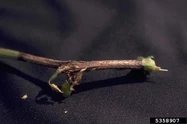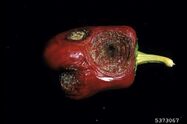| Phoma | |
|---|---|
 |
|
| Phoma blight (P. exigua var. exigua) on a bean leaf | |
| Scientific Classification | |
| Kingdom: | Fungi |
| Phylum: | Ascomycota |
| Class: | Dothideomycetes |
| Subclass: | Pleosporomycetidae |
| Order: | Pleosporales |
| Family: | Incertae sedis |
| Genus: | Phoma |
Phoma is a genus of about 140 taxa of plant pathogenic species.
Important species[]
Important species of Phoma:
- P. andigena
- P. cucurbitacearum
- P. destructiva
- P. exigua
- P. exigua var. exigua
- Phoma blight of beans & cucurbits
- P. exigua var. foveata
- P. exigua var. exigua
- P. terrestris
Symptoms[]
Bean[]
- Main article: Phoma blight
Cucurbits[]
- Main article: Phoma blight
The spots on cucurbit leaves produced by the Phoma blight are usually more irregular in shape and most often are on the margin of the leaves. The spots are light brown on cantaloupe and cucumber and dark brown on watermelon. Fewer lesions are produced on stems but symptoms also tend to spread from the crown of the plant, giving the plant a blighted appearance. Fruit are generally not affected.[1]
Tomato[]
- Main article: Phoma rot
In its earliest stages, Phoma rot of green fruit is marked by minute, slightly sunken spots. As these spots enlarge they develop brown or black borders with slightly lighter centers which become dotted with black pimple-like bodies (pycnidia) in which the seedlike bodies, or spores, of the fungus are borne.[2]
On the plant; spots are seen on the leaves, leaf petioles, and the stems of the vines. (PI. I.) Spotted leaves dry out and are shed. In the early stages the spots on the leaves are mereiy small discolored areas, later turning brown or black, which are definite in outline. These spots enlarge, and often several merge into a large blotch. On petioles and stems the diseased areas appear as streaks or blotches.[2]
Onion[]
- Main article: Pink root of onion
Potato[]
Black potato blight[]
- Main article: Black potato blight
Gangrene[]
- Main article: Gangrene
Treatment[]
Spotted fruit, even though unsightly, is fit for food provided the diseased parts are cut away.[2]
Chemical[]
A fungicide such as benomyl (Benlate), chlorothalonil (Bravo), copper, maneb (Manzate D or Dithane M-22 Special), mancozeb (Dithane M-45 or Manzate 200) or Dikar (Polyram) may be used to control the disease in the field. It is important to start the spray schedule as soon as the plants emerge and spray at 7-10 day intervals, covering all plant surfaces. High pressure (400 psi), high volume (100 gal/acre for a mature crop) spray equipment provides most effective coverage.[1]
Prevention[]
Crop rotations with nonhost plants such as small grain, corn, of two or more years are effective in reducing the incidence if disease-free seed are used. Currently no varieties are resistant.[1]
Examples[]
References[]
- ↑ a b c Averre, C.W. (1999). Gummy Stem Blight and Phoma Blight on Cucurbits. North Carolina State University - College of Agriculture and Life Sciences. Vegetable Disease Information Note 8 (VDIN-008). Retrieved: 2010-08-03.
- ↑ a b c Link, G.K.K. Meier, F.C. (1922). Phoma rot of tomatoes. United States Department of Agriculture. Department Circular 219. 002 815 845 2



